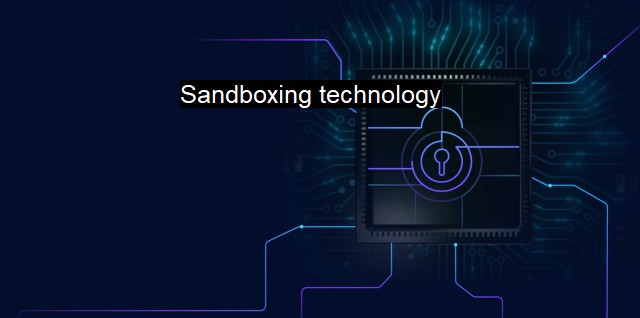What is Sandboxing technology?
Exploring Sandboxing Technology: The Virtualization Approach to Securing Cyber Space Against Malware and Cyber Threats
Sandboxing technology is a cybersecurity strategy that is primarily used to isolate a system, run programs and codes in an isolated environment, particularly those that are potentially harmful or untested, thus thwarting them from spreading or causing damage in the network or on the device. It essentially creates a controlled setting separate from the rest of your system where unknown or untrusted programs or code can be safely executed and scrutinized.At its core, sandboxing operates on the principle of containment. When sandboxing technology is deployed, it acts as a secure and controlled environment, much like a child's sandbox, where you can execute, allow to interact, observe, and analyse unauthorized or unverified code in a controlled manner. Once the program or code is contained within the sandbox, even if it turns out to be malicious in nature, it cannot breach the sandbox and infect, harm, or interact with the rest of the system files.
One of the essential aspects of sandboxing technology is its implementation within antivirus solutions. Antivirus software leverages sandboxing to isolate and test files, applications, and websites that might pose a potential threat or are unrecognizable. This allows the antivirus software to analyze and understand the behavior of the potentially harmful file, application, or URL. Upon detection of any malicious or suspicious behavior, it can then neutralise the threat, preventing it from doing any more harm.
Through the use of sandboxing, antivirus software has evolved to not only scan the known viruses but also identify new malware threats based on their behavior. This is particularly effective in dealing with zero-day threats which can be missed by traditional antivirus solutions that rely on known virus signatures. By running these potential threats in a secure and isolated environment, sandboxing can stop these new threats from affecting the larger system irrespective of them being previously identified or not.
Sandboxing technology is versatile and can be employed in varying forms and levels, depending on the level of security needed. This can range from full machine emulation where an entire separate machine is emulated, process-level sandboxing where a single new process is started in isolation, or even at a lighter level where the suspect code is run in a restricted-use environment with limited need for resources and privileges.
While sandboxing technology presents a significant shift and upgrade upon conventional security architecture with it is not completely infallible. Advanced threats have shown capabilities to understand when they're executed within a sandbox, remaining dormant during analysis to pass off as safe applications, and then causing harm once executed outside the sandbox environment within the actual system.
Despite some potential vulnerabilities, innovative enhancements are being worked upon to make these environments more deceptive and less identifiable to potential threats. In fact, sandboxing technology and techniques have been continually evolving and adapting to the ever-changing cybersecurity threat landscape, understanding, anticipating, and innovating better measures to counter specific opposing tactics shown by viruses and malware.
Sandboxing functions as a vital component of modern cybersecurity and antivirus solutions by offering a secure bubble for isolating and analyzing potential cyber threats. Sandbox technology provides the much-needed runway for risk assessment, testing, and threat mitigation before there can be an intrusion into the overall system. Although not entirely foolproof, continuous evolutions and enhancements in sandboxing technology are working towards creating secure and reliable cybersecurity environments.

Sandboxing technology FAQs
What is sandboxing technology?
Sandboxing technology is a cybersecurity technique that isolates potentially malicious software or code within a virtual environment. It allows the software or code to run in a controlled environment without harming the actual system.How does sandboxing technology work?
Sandboxing technology works by creating a virtual environment that mimics a real operating system, complete with its own set of files and processes. When a potentially malicious file or code enters the system, it is redirected to the sandbox environment. Here, it can be analyzed and tested for any malicious behavior or activities.What are the benefits of using sandboxing technology for antivirus systems?
Using sandboxing technology for antivirus systems has several benefits, including providing an extra layer of protection from previously unknown malware or viruses, allowing for safe testing of suspicious files, and minimizing the risk of false positives. It can also help prevent malware from spreading to other systems by containing it within the virtual environment.Can sandboxing technology completely prevent cyber attacks?
While sandboxing technology is a powerful cybersecurity tool, it is not foolproof and cannot completely prevent cyber attacks. Attackers can still find ways to bypass sandboxing environments or exploit vulnerabilities within the system. However, using sandboxing technology as part of a comprehensive cybersecurity strategy can significantly reduce the risk of successful cyber attacks.| | A | | | B | | | C | | | D | | | E | | | F | | | G | | | H | | | I | | | J | | | K | | | L | | | M | |
| | N | | | O | | | P | | | Q | | | R | | | S | | | T | | | U | | | V | | | W | | | X | | | Y | | | Z | |
| | 1 | | | 2 | | | 3 | | | 4 | | | 7 | | | 8 | | |||||||